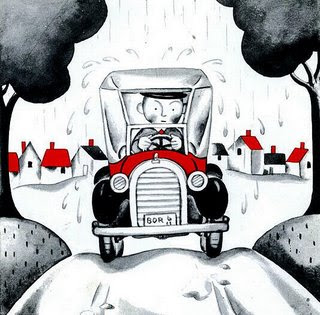Lois Lenski
July 11, 2012

JANE S. writes:
When I was a child, I loved reading Lois Lenski. She wrote and/or illustrated more than 100 books, as well as poetry, songs, and plays. Sadly, her books getting hard to find.
One of the things that makes her stories so precious is that they offer a glimpse of a time when there were distinct differences between regions of America. Differences in the way people dressed, in their style of cooking, in the ways they entertained themselves. This is in contrast to today, where America is more and more like a continuous, coast-to-coast strip mall.
In the foreword to one book, she talks about how she became inspired to write songs:
“My deep interest in our American regions stimulated me to write songs to interpet the lives of my Regional children, songs such as these children might write themselves, were they articulate. . . I have wanted them to illuminate the real environment – desert, woodland, mountain, city, river, cottonfields – where real children live; and to make it vivid and understandable to other children who have never been in these places at all.”
She goes on to write:
“When the fifth Regional, Cotton in my Sack, (published 1949) was in preparation, I discovered that the only cotton-picking songs were Negro in origin. The white cotton-picker had been too inarticulate to express himself in song, so I was inspired to write “Sun Up in the Mornin.” This provided the necessary spark. It was the cotton child’s need to have some one to speak for him that moved me to write poetry again.”
Here is part of Lenski’s book Strawberry Girl on Google books.
—– Comments —-
Penny writes:
Thank you so much for posting Jane S.’s comments on Lois Lenski. When I was a girl I read all of her books that the library had – Strawberry Girl, Cotton in my Sack, Flood Friday, Prairie School, etc. What drew me to them was Lenski’s way of telling a story and the different ways of life she described. Now I work in that same library and those same copies still sit on the shelves – mainly untouched. Today’s children (at least in my district) find them too “old-fashioned”, too difficult to read (though Lenski’s prose is clear and descriptive), too foreign – because they can’t be troubled to imagine a way of life different than their own. We had a teacher once who used to read Indian Captive: the story of Mary Jemison to her students every year. The last two or three years of her career, she reluctantly quit reading it – the students wanted something newer, something that didn’t make them think so hard. It’s a shame. I hope other librarians and parents are having better luck introducing children to the joys of Lois Lenski.
Jill Farris writes:
Penny, keep pointing your young library patrons to authors like Lois Lenski. We love her and appreciate her in our home and I loved her when I was a child. I am encouraging one of my children to compete in a speech competition with excerpts taken from Strawberry Girl because the regional dialects in her books are so flavorful!
There are few really good librarians in this day and age so keep up the good work of appreciating worthwhile authors! I know that many libraries constantly get rid of the “old” to make way for the new and am always appalled at the really good books they discontinue keeping on the shelves.
The good news is that Lois Lenski is still being published. We use a literature rich homeschool curriculum (Sonlight) and receive her books in the plethora of quality books they have compiled to be read and enjoyed.
